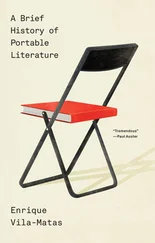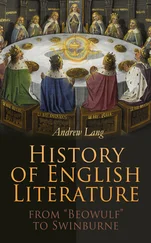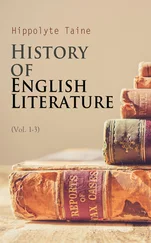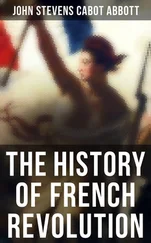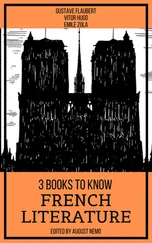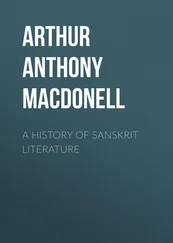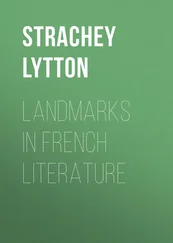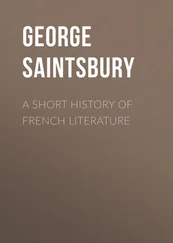Edward Dowden - A History of French Literature
Здесь есть возможность читать онлайн «Edward Dowden - A History of French Literature» — ознакомительный отрывок электронной книги совершенно бесплатно, а после прочтения отрывка купить полную версию. В некоторых случаях можно слушать аудио, скачать через торрент в формате fb2 и присутствует краткое содержание. Жанр: foreign_prose, foreign_home, Критика, Языкознание, foreign_antique, на английском языке. Описание произведения, (предисловие) а так же отзывы посетителей доступны на портале библиотеки ЛибКат.
- Название:A History of French Literature
- Автор:
- Жанр:
- Год:неизвестен
- ISBN:нет данных
- Рейтинг книги:3 / 5. Голосов: 1
-
Избранное:Добавить в избранное
- Отзывы:
-
Ваша оценка:
- 60
- 1
- 2
- 3
- 4
- 5
A History of French Literature: краткое содержание, описание и аннотация
Предлагаем к чтению аннотацию, описание, краткое содержание или предисловие (зависит от того, что написал сам автор книги «A History of French Literature»). Если вы не нашли необходимую информацию о книге — напишите в комментариях, мы постараемся отыскать её.
A History of French Literature — читать онлайн ознакомительный отрывок
Ниже представлен текст книги, разбитый по страницам. Система сохранения места последней прочитанной страницы, позволяет с удобством читать онлайн бесплатно книгу «A History of French Literature», без необходимости каждый раз заново искать на чём Вы остановились. Поставьте закладку, и сможете в любой момент перейти на страницу, на которой закончили чтение.
Интервал:
Закладка:
Le Chèvrefeuille (The Honeysuckle), one of several lais by a twelfth-century poetess, MARIE, living in England, but a native of France, tells gracefully of an assignation of Tristan and Iseut, their meeting in the forest, and their sorrowful farewell. Marie de France wrote with an exquisite sense of the generosities and delicacy of the heart, and with a skill in narrative construction which was rare among the poets of her time. In Les Deux Amants , the manly pride of passion, which in a trial of strength declines the adventitious aid of a reviving potion, is rewarded by the union in death of the lover and his beloved. In Yonec and in Lanval tales of love and chivalry are made beautiful by lore of fairyland, in which the element of wonder is subdued to beauty. But the most admirable poem by Marie de France is unquestionably her Eliduc . The Breton knight Eliduc is passionately loved by Guilliadon, the only daughter of the old King of Exeter, on whose behalf he had waged battle. Her tokens of affection, girdle and ring, are received by Eliduc in silence; for, though her passion is returned, he has left in Brittany, unknown to Guilliadon, a faithful wife. Very beautiful is the self-transcending love of the wife, who restores her rival from seeming death, and herself retires into a convent. The lovers are wedded, and live in charity to the poor, but with a trouble at the heart for the wrong that they have done. In the end they part; Eliduc embraces the religious life, and the two loving women are united as sisters in the same abbey.
Wace, in his romance of the Brut (1155), which renders into verse the Historia of Geoffrey of Monmouth, makes the earliest mention of the Round Table. Whether the Arthurian legends be of Celtic or of French origin—and the former seems probable—the French romances of King Arthur owe but the crude material to Celtic sources; they may be said to begin with CHRÉTIEN DE TROYES, whose lost poem on Tristan was composed about 1160. Between that date and 1175 he wrote his Erec et Enide (a tale known to us through Tennyson's idyll of Geraint and Enid, derived from the Welsh Mabinogion ), Cligès , Le Chevalier de la Charrette , Le Chevalier au Lion , and Perceval . In Cligès the maidenhood of his beloved Fénice, wedded in form to the Emperor of Constantinople, is guarded by a magic potion; like Romeo's Juliet, she sleeps in apparent death, but, happier than Juliet, she recovers from her trance to fly with her lover to the court of Arthur. The Chevalier de la Charrette , at first unknown by name, is discovered to be Lancelot, who, losing his horse, has condescended, in order that he may obtain sight of Queen Guenièvre, and in passionate disregard of the conventions of knighthood, to seat himself in a cart which a dwarf is leading. After gallant adventures on the Queen's behalf, her indignant resentment of his unknightly conduct, estrangement, and rumours of death, he is at length restored to her favour. 6 6 Chrétien de Troyes is the first poet to tell of the love of Lancelot for the Queen.
While Perceval was still unfinished, Chrétien de Troyes died. It was continued by other poets, and through this romance the quest of the holy graal became a portion of the Arthurian cycle. A Perceval by ROBERT DE BORON, who wrote in the early part of the thirteenth century, has been lost; but a prose redaction of the romance exists, which closes with the death of King Arthur. The great Lancelot in prose—a vast compilation—(about 1220) reduces the various adventures of its hero and of other knights of the King to their definitive form; and here the achievement of the graal is assigned, not to Perceval, but to the saintly knight Sir Galaad; Arthur is slain in combat with the revolter Mordret; and Lancelot and the Queen enter into the life of religion. Passion and piety are alike celebrated; the rude Celtic legends have been sanctified. The earlier history of the sacred vase was traced by Robert de Boron in his Joseph d'Arimathie (or the Saint-Graal ), soon to be rehandled and developed in prose; and he it was who, in his Merlin —also presently converted into prose—on suggestions derived from Geoffrey of Monmouth, brought the great enchanter into Arthurian romance. By the middle of the thirteenth century the cycle had received its full development. Towards the middle of the fourteenth century, in Perceforest , an attempt was made to connect the legend of Alexander the Great with that of King Arthur.
Beside the so-called Breton romances, the Épopée courtoise may be taken to include many poems of Greek, of Byzantine, or of uncertain origin, such as the Roman de la Violette , the tale of a wronged wife, having much in common with that novel of Boccaccio with which Shakespeare's Cymbeline is connected, the Floire et Blanchefleur ; the Parténopeus de Blois , a kind of "Cupid and Psyche" story, with the parts of the lovers transposed, and others. In the early years of the thirteenth century the prose romance rivalled in popularity the romance in verse. The exquisite chante-fable of Aucassin et Nicolette , of the twelfth century, is partly in prose, partly in assonanced laisses of seven-syllable verse. It is a story of the victory of love: the heir of Count Garin of Beaucaire is enamoured of a beautiful maiden of unknown birth, purchased from the Saracens, who proves to be daughter of the King of Carthage, and in the end the lovers are united. In one remarkable passage unusual sympathy is shown with the hard lot of the peasant, whose trials and sufferings are contrasted with the lighter troubles of the aristocratic class.
In general the poems of the Épopée courtoise exhibit much of the brilliant external aspect of the life of chivalry as idealised by the imagination; dramatic situations are ingeniously devised; the emotions of the chief actors are expounded and analysed, sometimes with real delicacy; but in the conception of character, in the recurring incidents, in the types of passion, in the creation of marvel and surprise, a large conventional element is present. Love is independent of marriage, or rather the relation of wedlock excludes love in the accepted sense of the word; the passion is almost necessarily illegitimate, and it comes as if it were an irresistible fate; the first advance is often made by the woman; but, though at war with the duty of wedlock, love is conceived as an ennobling influence, prompting the knight to all deeds of courage and self-sacrifice. Through the later translation of the Spanish Amadis des Gaules , something of the spirit of the mediæval romances was carried into the chivalric and pastoral romances of the seventeenth century.
CHAPTER II
LYRICAL POETRY—FABLES, AND RENARD THE FOX—FABLIAUX—THE ROMANCE OF THE ROSE
I
LYRICAL POETRY
Long before the date of any lyrical poems that have come down to us, song and dance were a part of the life of the people of the North as well as of the South of France; religious festivals were celebrated with a gaiety which had its mundane side; love and malicious sport demanded an expression as well as pious joy. But in tracing the forms of lyrical verse anterior to the middle of the twelfth century, when the troubadour influence from the South began to be felt, we must be guided partly by conjecture, derived from the later poetry, in which—and especially in the refrains—earlier fragments have been preserved.
The common characteristic which distinguishes the earlier lyrics is the presence in them of an objective element: they do not merely render an emotion; they contain something of a story, or they suggest a situation. In this literature of sentiment, the singer or imagined singer is commonly a woman. The chanson d'histoire is also known as chanson de toile , for the songs were such as suited "the spinsters and the knitters in the sun." Their inspiring motive was a girl's joy or grief in love; they lightly outline or suggest the facts of a miniature drama of passion, and are aided by the repeated lyrical cry of a refrain. As yet, love was an affair for the woman; it was she alone who made a confession of the heart. None of these poems are later than the close of the twelfth century. If the author be represented as actor or witness, the poem is rather a chanson à personnages than a chanson d'histoire ; most frequently it is a wife who is supposed to utter to husband, or lover, or to the poet, her complaint of the grievous servitude of marriage. The aube is, again, a woman's song, uttered as a parting cry when the lark at daybreak, or the watcher from his tower, warns her lover to depart. In the pastourelle —a form much cultivated—a knight and a shepherdess meet; love proposals are made, and find a response favourable or the reverse; witnesses or companions may be present, and take a part in the action. The rondet is a dancing-song, in which the refrain corresponds with one of the movements of the dance; a solo-singer is answered by the response of a chorus; in the progress of time the rondet assumed the precise form of the modern triolet; the theme was still love, at first treated seriously if not tragically, but at a later time in a spirit of gaiety. It is conjectured that all these lyrical forms had their origin in the festivities of May, when the return of spring was celebrated by dances in which women alone took part, a survival from the pagan rites of Venus.
Читать дальшеИнтервал:
Закладка:
Похожие книги на «A History of French Literature»
Представляем Вашему вниманию похожие книги на «A History of French Literature» списком для выбора. Мы отобрали схожую по названию и смыслу литературу в надежде предоставить читателям больше вариантов отыскать новые, интересные, ещё непрочитанные произведения.
Обсуждение, отзывы о книге «A History of French Literature» и просто собственные мнения читателей. Оставьте ваши комментарии, напишите, что Вы думаете о произведении, его смысле или главных героях. Укажите что конкретно понравилось, а что нет, и почему Вы так считаете.

